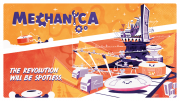Mechanica (Resonym) – All players are trying to build a robot factory. Each player has a game board into which puzzle pieces can be slotted. Robots start at one end of your board and make their way across a treadmill, at the end of which they are put on trucks to be sold and make money. Players can then use the money to buy factory parts (puzzle pieces) which they can add to their factories. The factory parts are on a rotating board set into the game box. When the pieces rotate, the prices for each go down. When you buy a piece you can either slot it into your factory or recycle it into new robots. When a factory piece makes its way all the way around the rotating board, it falls down a hole and the player whose turn it is recycles it for free. Factory pieces on your board will manipulate your robots in multiple different ways, such as moving them towards different trucks, gift wrapping them, turning them into different types of robots, jumping them over things, and so forth. As long as the puzzle pieces fit together like a proper puzzle, you may add them anywhere into your factory.
Casual Games on Kickstarter: Puzzles, Psychics, and Parks

February on Kickstarter offers an exciting batch of casual games, from a party game co-designed by the creator of The Mind to a board game featuring robots and puzzle pieces. Also this month is a game that celebrates the national parks and some intriguing, strategical two-player games.
Wavelength (Alex Hague) – Designed by the creators behind The Mind and Monikers, Wavelength is a party game with two teams. The game features a dial that you can rotate. Under the dial's needle is a screen which hides a bullseye on a spectrum — the position on the spectrum is changed each round. One player on your team, the psychic, knows exactly where the bullseye is and it is their job to get the team to move the dial to the bullseye. A card is drawn which will have two words that form two ends of a spectrum, such as 'quiet place' and 'loud place'. The psychic then gives a clue word that is between these two extremes. The rest of the team must then discuss, based on this clue, where they believe the bullseye is located on the spectrum. For instance, in the 'quite/loud place' example, if the clue is 'concert' they can deduce that the bullseye is likely towards the 'loud place' end of the spectrum. Once the team has moved the dial to a position they think is correct on the spectrum, the bullseye is revealed. The closer to the bullseye they guess, the more points they earn. The opposing team also has a chance to earn one point before the answer is revealed by guessing if they believe if the bullseye is to the left or the right of the dial after the guessing team locks in their answer.
Parks (Keymaster Games) – Parks is a game about visiting national parks and features artwork from the Fifty-Nine Parks Print Series. Each player takes control of two hikers. The game is played over four seasons of a year. A trail is created by shuffling site cards together and laying them face up in a row. Seasonal weather tokens are placed on these. Players take turns moving their hikers down the trail and collecting tokens based on the card their hiker lands on. You may only move your hiker onto a space already occupied by another hiker if you have not yet used your campfire this season. Once they reach the end of the trail, players may spend tokens to upgrade their gear and visit national parks. Each season the trail is reshuffled with a new site card added to it, and the new season's weather tokens are used.
TacTiki (Armored Panda) – This abstract board game is played on a board with a five by five grid of squares. Each player has ten pieces, numbered one to five on their backs, and start on opposite sides of the board, with two pieces stacked on each of their starting spaces. Players may choose, as they set up their pieces, which numbered pieces to put where in their starting setup. Only you may see the numbers on your pieces, you cannot see your opponent's numbers. The numbers on the back of your pieces is their strength. The higher the number, the stronger it is, however there is one exception: one beats the number five. If two opposing pieces occupy the same space, both players reveal the numbers on the pieces and the losing piece is removed from the board. The number of the surviving piece is then hidden again. This introduces a memory mechanic into the game as you attempt to remember the numbers you've seen on your opponent's pieces. On your turn you choose to either move or to bring back one of your defeated pieces and place it on one of your unoccupied starting spaces. When moving you must either move one piece twice or two pieces once each. Pieces may move left, right, or forward, but not backwards or diagonally. You may move one of your pieces onto of a stack of one or more of your other pieces; however stacks do not move as a whole. The first player to create a stack of five pieces on one of her opponent's starting squares wins the game.
Crimson Company (Dario Reinhardt and Fabian Fischer) – In this two player competitive card game, players are battling over three castles. The first player to win two castles wins the game. Castles are conquered by assembling a group of cards, each of whom has a strength level and a unique ability. Both players make use of the same deck and the game is focused on creating a balanced experience. On your turn you start by placing a bid on a card, choosing from the four currently available. Your opponent may then choose to either pass, in which case you pay your bid to the bank and take the card, or they pay you the same amount of coins you just bid and they take the card. Next you choose which of the three castles to send your new card (if you won it) to fight over. Once a player has four or more cards committed to a specific castle, the strength values of both players’ cards are added up and the player with the highest strength value in the fight after all special effects are resolved, wins the castle.
hexaGONE (2HandsomeGames) – The game features a deck of sequence cards and multiple hexagon tiles which are placed in a bag. Players draw three hexagon tiles from the bag to create their hand at the start of the game. On your turn, you start by drawing a sequence card and placing it to the right of the deck. If there are already three cards there, you discard the oldest one. Sequence cards show various configurations of hexes. Next you place hexagons from your hand to the board or pass. If you pass you can return any number of hexagons and draw the same number into your hand and your turn ends. If you do not pass you must play at least one hexagon. When you place a tile it must connect to at least one hex already on the table. If a sequence card matches the configuration of hexes on the table you claim it and earn the points that it is worth. Some hexagons allow you to perform special actions such as swapping the position of any two hexagons on the board or drawing two hexagons from the bag.
Rival Restaurants (Gap Closer Games) – Choose one of twelve different chefs, each with their own special ability. Each player will also choose one of eight restaurants and compete to make their restaurant the most successful. Each turn is divided into three phases. During phase one you earn your income and choose one of six markets to shop at, or you may choose to buy action cards and upgrades for your restaurant. During the second phase, all players have one minute to buy ingredients from the board and trade with opponents. During the third phase players use their ingredient cards to complete recipes and earn points. The first player to earn twenty points wins the game.
Disclosure: unless otherwise noted, we have not seen or played any of the above games. Our assessment of each is based on the information given on the crowdfunding project page.











